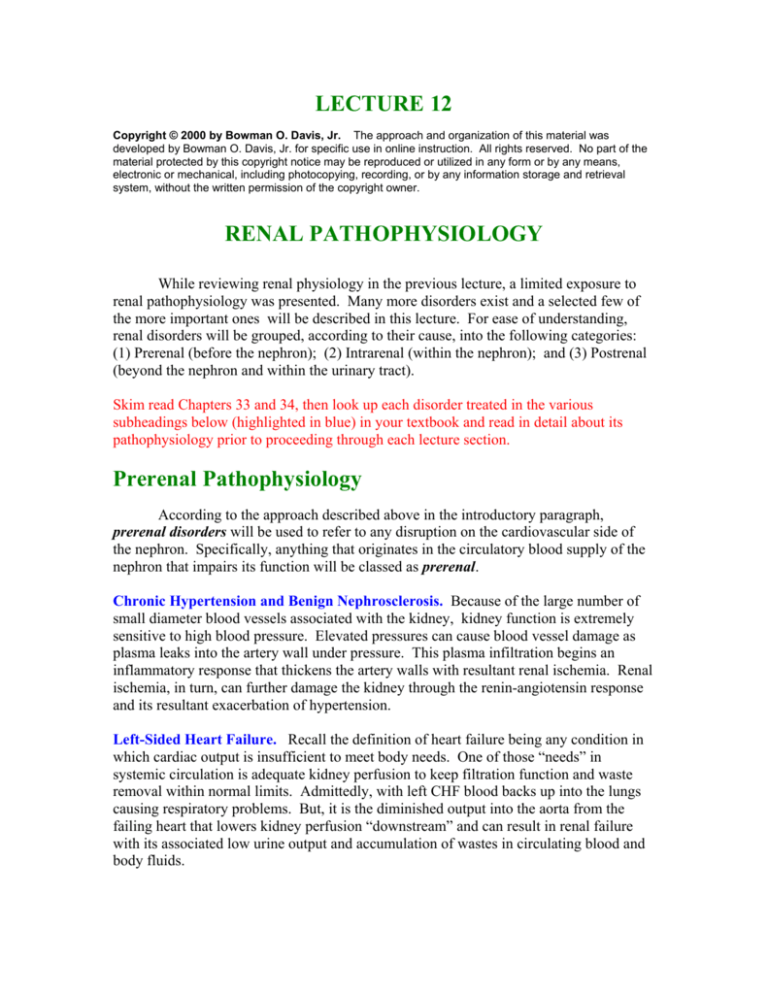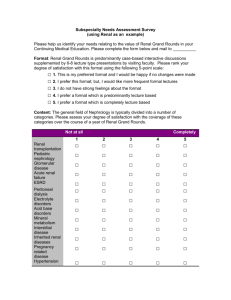
LECTURE 12
Copyright © 2000 by Bowman O. Davis, Jr. The approach and organization of this material was
developed by Bowman O. Davis, Jr. for specific use in online instruction. All rights reserved. No part of the
material protected by this copyright notice may be reproduced or utilized in any form or by any means,
electronic or mechanical, including photocopying, recording, or by any information storage and retrieval
system, without the written permission of the copyright owner.
RENAL PATHOPHYSIOLOGY
While reviewing renal physiology in the previous lecture, a limited exposure to
renal pathophysiology was presented. Many more disorders exist and a selected few of
the more important ones will be described in this lecture. For ease of understanding,
renal disorders will be grouped, according to their cause, into the following categories:
(1) Prerenal (before the nephron); (2) Intrarenal (within the nephron); and (3) Postrenal
(beyond the nephron and within the urinary tract).
Skim read Chapters 33 and 34, then look up each disorder treated in the various
subheadings below (highlighted in blue) in your textbook and read in detail about its
pathophysiology prior to proceeding through each lecture section.
Prerenal Pathophysiology
According to the approach described above in the introductory paragraph,
prerenal disorders will be used to refer to any disruption on the cardiovascular side of
the nephron. Specifically, anything that originates in the circulatory blood supply of the
nephron that impairs its function will be classed as prerenal.
Chronic Hypertension and Benign Nephrosclerosis. Because of the large number of
small diameter blood vessels associated with the kidney, kidney function is extremely
sensitive to high blood pressure. Elevated pressures can cause blood vessel damage as
plasma leaks into the artery wall under pressure. This plasma infiltration begins an
inflammatory response that thickens the artery walls with resultant renal ischemia. Renal
ischemia, in turn, can further damage the kidney through the renin-angiotensin response
and its resultant exacerbation of hypertension.
Left-Sided Heart Failure. Recall the definition of heart failure being any condition in
which cardiac output is insufficient to meet body needs. One of those “needs” in
systemic circulation is adequate kidney perfusion to keep filtration function and waste
removal within normal limits. Admittedly, with left CHF blood backs up into the lungs
causing respiratory problems. But, it is the diminished output into the aorta from the
failing heart that lowers kidney perfusion “downstream” and can result in renal failure
with its associated low urine output and accumulation of wastes in circulating blood and
body fluids.
Glomerulonephritis. In this condition, antibody complexes resulting from a recent
infection collect on the glomerular membrane on the circulatory side and cause a
secondary glomerular inflammation. This glomerular inflammation can cause permanent
nephron damage by fibrous connective tissue infiltration which interferes with the
glomerular filtration process. Streptococcal infections are notorious as causative agents
of acute glomerulonephritis. Consequently, something as simple as a “strep throat” can
have serious consequences.
Intrarenal Pathophysiology
With intrarenal disorders, the problem arises from within the nephron tubules
themselves, at some point from the proximal tubule to the collecting duct. It is difficult
to imagine damage so specific as to damage the inner nephron without affecting either
end unless attention is given to bacterial toxins and accidentally ingested materials, such
as pesticides, herbicides, heavy metals, antifreeze, certain cleaning fluids, and
nephrotoxic drugs.
Toxins (Acute Tubular Necrosis, ATN). Many bacteria, especially certain strains of
Escherichia coli, secrete toxic materials that can be damaging to the host. In humans,
these toxins may exist in circulating blood at levels too low to cause problems until they
are filtered into the nephron across the glomerulus. Once filtered into the nephron,
tubular reabsorption results in these toxins being concentrated in the nephron, eventually
reaching a concentration high enough to damage nephron tubule cells (tubular necrosis).
A recent event involving a recreational water park in north Atlanta gained notoriety when
fecal contaminants containing E. coli were ingested with inadequately chlorinated water.
The affected children experienced varying degrees of renal impairment.
A similar situation exists with the other accidentally ingested materials listed in
the introductory paragraph. And, the etiology of the resultant kidney dysfunction in these
situations is comparable.
Postrenal Pathophysiology
Postrenal disorders are those that originate in the urinary tract “downstream” from
the nephrons of the kidney. These disorders can involve the renal pelvis, the ureters or
the bladder and urethra.
Renal Calyx (Kidney Stone). Kidney stones result from crystalline materials that occur
in urine in concentrations sufficient to cause aggregate crystals that grow into stones
within the renal pelvis. Once formed, these stones can move into the ureters and lodge
causing intense pain until they are passed naturally or are removed surgically or disrupted
by ultrasound treatments. A common kidney stone develops from calcium oxylate salts
in people with high calcium and oxalic acid in their diets. Such stones are prevalent in
people in the South. In fact, southerners have triple the incidence of other regions.
Calcium comes primarily from dairy products and leafy green vegetables, both of which
are common in southern diets. Oxylates come from plant extracts (coffee, tea, and cola),
which are also common in southern diets. Considering both of these factors, when
combined with dehydration as is common in southern climates, it is not surprising that
the rate among Southerners is so high.
Pyelonephritis. Pyelonephritis is a condition which develops when infectious
microorganisms establish in the urinary tract and migrate upward into kidney tissue. The
incidence is particularly high in individuals who contaminate the urethra with fecal
material containing E. coli as a result of poor hygiene or are unable to completely void
the bladder for some reason. The urinary retention leads to excess microbial growth and
eventual spread into the kidneys.
Renal Failure
No treatise of renal disease would be complete without a discussion of renal
failure. Renal failures can be acute, lasting only for a short time, or chronic, developing
over and continuing for an extended period of time. Chronic renal failures result when
over 70% of nephrons are permanently lost and require dialysis to sustain life. From the
point at which dialysis or transplantation is required to sustain life, the condition is
termed end stage renal failure.
Basically, the etiology of any type of renal failure can be quite varied and depends
upon the particular event that initiates the kidney damage. If uncorrected, any of the
events described above can lead to renal failure. One type of renal failure is relatively
rare and termed “nonconcentrating” in which reabsorption fails and high urine output
results in danger of dehydration and loss of essential nutrients. This type will not be
considered here.
The most common category of renal failure is one in which urine production fails
and urine output drops below 30 cc per hour. Under these conditions, fluid expansion
occurs with elevated blood pressure and wastes accumulating to dangerous levels.
Azotemia is the accumulation of nonprotein nitrogenous wastes, such as urea, uric acid
and creatinine. The condition of existing azotemia is termed uremia or uremic
poisoning. In uremia, these wastes along with other accumulated salts are excreted in
sweat and deposited in soft tissues of skin. With sweat evaporation, these salts
accumulate on the surface of the skin resulting in uremic “frosting”.
REVIEW QUESTIONS:
1. Explain why clients with renal problems are put on low protein diets.
2. Why isn’t all of blood calcium lost in the urine?
3. Why is the ingestion of poorly washed fruits and vegetables risky?
4. Review each of the renal disorders in this lecture and explain why they are classed
as pre-, intra-, or postrenal by cause.
DISCUSSION QUESTIONS: (Post answers to the “Patho Discussion Group”)
1. Describe step-by-step how a sore throat could lead to dialysis.
2. How (step-by-step) could renal failure lead to left CHF and vice versa.








